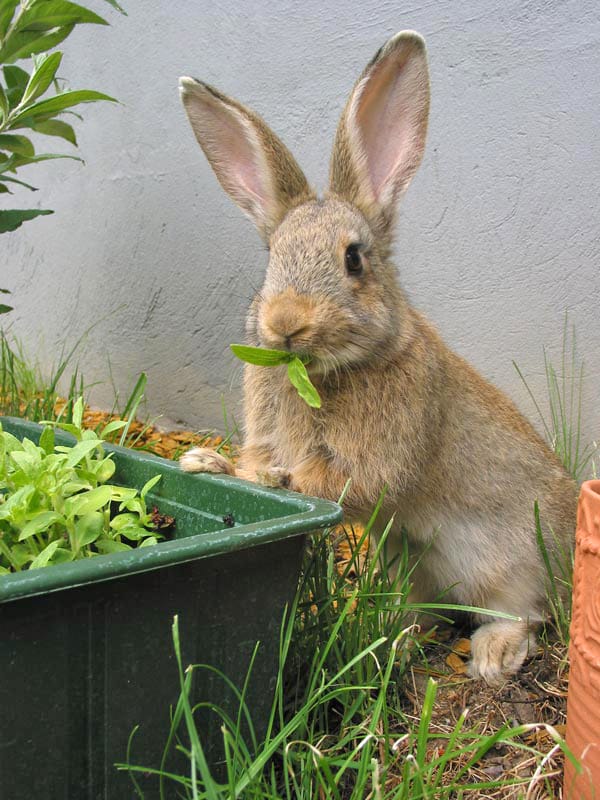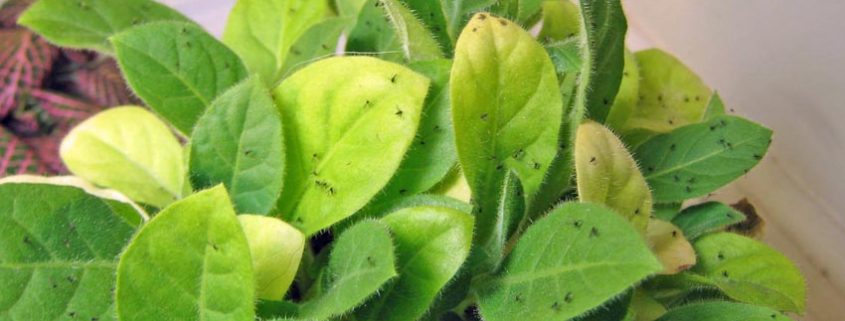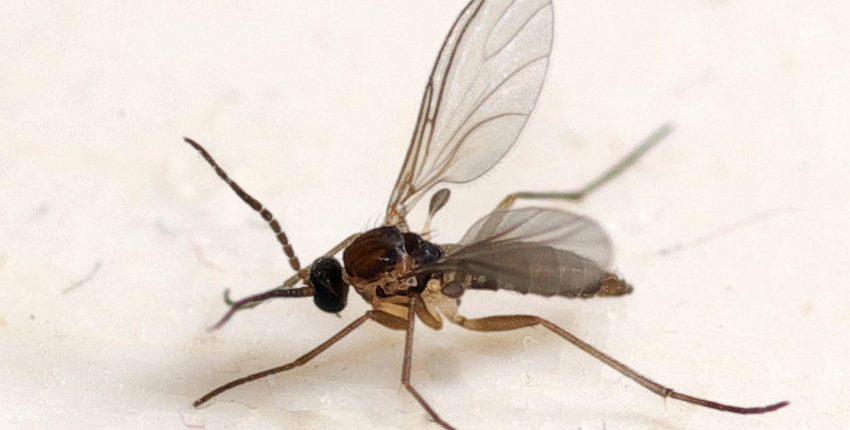One of the biggest questions we are often asked is what to do about furry and/or feathered critters that want to snack on our gardens. There are a lot of approaches, and we realized that our customers have more experiences to share that can help more folks, so we put out the question of what has been successful in helping to deter critters from your garden?
We received some great replies that we’ve included here. We’ll start off with perhaps one of the most challenging garden conditions in the US – at the South rim of the Grand Canyon national park. Here elk and other wildlife are protected, and there is a short growing season to contend with.
Deb from AZ writes – “Since we are in Grand Canyon National Park, wildlife is our #1 challenge…we have to have an 8 ft. fence around our garden to keep the elk out. Rodents are also a huge problem here: gophers, mice, voles, and chipmunks/squirrels. I feel like we have become pretty skilled at working around them!
Here’s what we have learned to do:
- Move the compost far from the garden: our three-bin system had become a rodent motel and led to a population explosion. Once we got rid of that, things calmed down a bit.
- We also use the hardware cloth under some of the beds and it works great for the gophers. Low hardware cloth fences stop them from digging in paths and peeking over into the beds to nibble. This also stops the voles, who can’t really climb. For beans and squash and tomatoes, we use a little hardware cloth ring around each plant in the early season until they get big enough to be unpalatable.
- For climbers like squirrels and chipmunks, we use “deer netting” over the top of our low fences to prevent climbing in.
- To stop mice and voles from eating seeds and sprouts, we lay sheets of metal window screens on top of the soil after planting. Once they sprout, we switch to the low fences as mentioned above.
This sounds like a ton of work, (and it is), but once you make all of these structures it doesn’t take too long to install them, and it really saves your crops from being decimated. Even the smallest critters are creatures of habit, so if you take the time to observe what they are doing you can often work around them or plant more attractive plants in less trafficked areas.
Most importantly, we have learned to be a little more Zen about the whole thing, and now just expect there to be some losses from critters. We always keep enough extra seeds of short-season crops to re-plant areas that are compromised!”
Regina from NC says – “Last year I planted a garden in a different area and found the deer just loved my cabbage, broccoli green beans – all my first plantings were eaten to a nub. I consulted a local expert (94 year old gardener) and was told the following:
Plant a wide row of green edibles outside the perimeter of your garden and then put a border of yellow ribbon tape (the type used at a crime scene) and leave it a little loose so that it moves and twists in the breeze.
I planted oats and clover outside the garden area and put the yellow ribbon around the garden. The deer ate the stuff outside the garden area and left my garden alone.
The expert advice from the seasoned veteran worked like a charm.”
Jim in IL found – “No exaggeration…last spring I would see 50 rabbits running around within a 1/2-mile radius. They were everywhere! Many times I would see 5 or 6 running/playing together. This obviously is a bad thing when you have a veggie garden! I have 8 raised beds (5×20′) which I also cover with row covers. The rabbits would even crawl under the protective covers and nest under my plants. I had to do something fast!
This past fall I put up a 4′ chain-link fence around my garden (approx. 35’x85′) which was really only to serve as a frame for the 1″x1″ (24″ tall) vinyl coated wire mesh fence I installed inside the chain-link. I buried the mesh 6″ deep to hopefully prevent the vermin from digging under. This spring will be the true test for my efforts.
I’m not sure if the chipmunks can squeeze in the 1″ holes, but just in case, I have traps for them. Last season I nailed 35 of them. Aggravating to do all this work only to have the critters get in for a free meal!”
Diane shared – “I wanted to share that after years of the birds and lizards destroying much of our newly-planted raised bed gardens, my husband has built some screen covers over our raised beds. He used 2 inch x 2 inch redwood posts for a frame, and attached wildlife netting to the frames. These are slightly larger than each raised bed’s opening. He placed the screen-covered frames on top of the raised beds, and no more early garden destruction! Our early Spring garden is thriving!”
Mary Lou in IL has learned – “The best trick I have is to put aluminum foil around small plants that I don’t want the chipmunks to dig up. They hate the aluminum foil and won’t dig up my new transplants. It is actually funny to watch their reaction when they try to dig and get the foil instead of dirt.”
Linda in NE shared – “I have found Aztec Marigolds work really, really well at keeping the bunnies away from my strawberries. I usually leave them in the ground till spring, but for some reason I pulled them all at the end of last season and have noticed a huge increase in the bunny population in my yard throughout this past winter. Next year I’ll leave them in till spring.
To keep the neighbors cats away from my “bird garden” I scatter rue seeds amongst the beds. It keeps the cats away, but it makes it hard to get in there to cut flowers for bouquets.
For the never ending wasps I rub a bar of soap around all the areas where they like to hang out. When I see a nest forming I liberally rub the soap all around that area. And I try to destroy all of the nests I find after the first freeze. I know wasps serve a purpose, but if they want a place in my yard it’s going to have to be away from the house and shed.
Chrys in PA shares some wisdom – “My uncle taught me an effective way to keep the crows from “unplanting” your corn as soon as your back is turned. Poke a hole in the ground about 1/2 inch deeper than normal, drop in the corn and cover it with dirt. Then take your digging stick and poke a hole about 1/2 inch deep over the corn. Maybe the birds think that another bird already harvested the seed, but they usually leave it alone.”
Here’s some of the things we’ve learned in our own garden over time:
Gophers – In our area, there are colonies of gophers living in the vacant field next to our house and garden. They will mostly stay on their side of the fence, but occasionally come under and cause havoc to our garden. Our dogs love to dig up their tunnels, but so far haven’t been able to capture one.
When we were constructing our raised beds, we installed hardware cloth in the bottom of the beds before putting the soil in. The hardware cloth is stout enough that it deters the gophers from trying to dig through and has held up for 6 years now. The challenge is that they will still come up in the walkways under the wood chips where there is no barrier! We resort to gopher traps for this – the Gophinator is by far the best and most effective trap of several designs and approaches we’ve tried.
We don’t trap any gophers that don’t get into the garden. If they are on the other side of the fence we leave them alone.
Squirrels – We generally don’t have squirrel problems, but one summer had a rogue agent that was climbing the fence and dining on our garden. The solution was to borrow a live trap from a friend, capture the little bandit and release it into another area that was far from any houses. In this case, we were able to relocate it without harming it.
Do you feed wild birds? You may be bringing in unwanted visitors like squirrels, mice and possibly raccoons as they scavenge the seed dropped from the feeders. There are a couple of solutions to this challenge: stop feeding the birds – this removes the food source and will decrease the visitation of wildlife, or move the bird feeder to a spot that is the furthest possible distance from your garden and use a feeder design that minimizes the amount of seed dropped by hungry birds.
Javalina – These wild relatives of pigs have poor eyesight, but a very keen sense of smell. If you put fresh kitchen scraps onto your compost pile, you might be attracting these large and destructive critters. If you live in javalina country, don’t locate the compost bin or pile next to the garden, use leaves and manure with kitchen scraps aged for a couple of weeks in a bucket instead. This way it isn’t as appealing to them and won’t encourage repeat visits.




